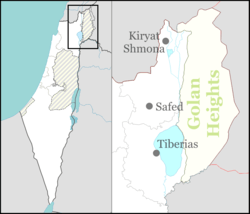Shibli–Umm al-Ghanam
Shibli–Umm al-Ghanam
| |
|---|---|
| Hebrew transcription(s) | |
| • ISO 259 |
Šibbli - ʔumm ˀel-Ránem (Israeli pronunciation) |
|
View of Shibli | |
 Shibli–Umm al-Ghanam | |
| Coordinates: 32°41′03″N 35°23′49″E / 32.68417°N 35.39694°ECoordinates: 32°41′03″N 35°23′49″E / 32.68417°N 35.39694°E | |
| Grid position | 186/231 PAL |
| District | Northern |
| Founded | 1992 |
| Government | |
| • Type | Local council (from 1992) |
| Area | |
| • Total | 2,879 dunams (2.879 km2 or 1.112 sq mi) |
| Population (2015)[1] | |
| • Total | 5,694 |
| Name meaning | Khirbet Umm el Ghanem = The ruin with the sheep[2] |
Shibli–Umm al-Ghanam (Arabic: الشبلي - أم الغنم, Hebrew: שִׁבְּלִי-אֻם אל-עַ'נַם) is an Arab town at the foot of Mount Tabor in Israel's Northern District. In 2015 it had a population of 5,694.
History
Archaeological excavations have revealed flint from the Mousterian culture, several knapped using the Levallois technique.[3]
Ottoman era
In 1517, the village was included in the Ottoman empire with the rest of Palestine, and in the 1596 tax-records it appeared as Um al-Ganam, located in the Nahiya of Tabariyya of the Liwa of Safad. The population was 8 households, all Muslim. They paid a fixed tax- rate of 25% on agricultural products, including wheat, barley and summer crops, in addition to occasional revenues, and goats and beehives; a total of 1910 Akçe.[4][5]
In 1875, Victor Guérin found here "several ancient cisterns, still unbroken, and ancient caves cut in rock, which now serve as refuge for shepherds."[6] In 1881 the Palestine Exploration Fund's Survey of Western Palestine found at Kh. Umm el Ghanem: "Heaps of stones, a few of which are hewn, all of small size, one small cave and one cistern."[7]
British Mandate era
In the 1922 census of Palestine conducted by the British Mandate authorities, Umm al Ghanam had a population of 52, all Muslims.[8] In the 1931 census the population of Umm al-Ghanam was counted with that of Reineh, together they had 1015 inhabitants in a total of 243 houses.[9]
In 1945 the population of Umm al-Ghanam was counted with that of Mount Tabor, and their the total land area was 8,409 dunams, according to an official land and population survey.[10] Of this, 232 dunams were allocated for plantations and irrigable land, 6,215 for cereals,[11] while a total of 1,962 dunams were classified as non-cultivable land.[12]
State of Israel
The town was formed in 1992 as a result of a municipal merger of the villages of Shibli and Umm al-Ghanam.
Shibli High School is attended by 270 Arab students, Special educational programs introduced at the school have boosted the Bagrut matriculation pass rate and percentage of graduates attending university.[13]
Hassan Saida of Shibli–Umm Al-Ghanam owns a collection of small cast lead books featuring what is believed to be the first-ever portrait of Jesus. The books are thought to have been created by followers of Jesus in the first decades after his crucifixion. The books, containing cryptic messages in Hebrew and ancient Greek, have been in Saida's family since they were found by his great-grandfather.[14]
See also
References
- ↑ "List of localities, in Alphabetical order" (PDF). Israel Central Bureau of Statistics. Retrieved 16 October 2016.
- ↑ Palmer, 1881, p. 130
- ↑ Tepper, 2015, ‘Ein Umm el-Ghanam
- ↑ Hütteroth and Abdulfattah, 1977, p. 189
- ↑ Note that Rhode, 1979, p. 6 writes that the register that Hütteroth and Abdulfattah studied was not from 1595/6, but from 1548/9
- ↑ Guérin, 1880, p. 140; as given in Conder and Kitchener, SWP I, p. 409
- ↑ Conder and Kitchener, SWP I, p. 409
- ↑ Barron, 1923, Table XI, Sub-district of Nazareth, p. 38
- ↑ Mills, 1932, p.73
- ↑ Government of Palestine, Department of Statistics. Village Statistics, April, 1945. Quoted in Hadawi, 1970, p. 62
- ↑ Government of Palestine, Department of Statistics. Village Statistics, April, 1945. Quoted in Hadawi, 1970, p. 110
- ↑ Government of Palestine, Department of Statistics. Village Statistics, April, 1945. Quoted in Hadawi, 1970, p. 160
- ↑ World ORT, Shibli High School
- ↑ Lost for 2,000 years... Could this be the first portrait of Jesus?
Bibliography
| Wikimedia Commons has media related to Shibli-Umm al-Ghanam. |
- Barron, J. B., ed. (1923). Palestine: Report and General Abstracts of the Census of 1922. Government of Palestine.
- Conder, Claude Reignier; Kitchener, H. H. (1881). The Survey of Western Palestine: Memoirs of the Topography, Orography, Hydrography, and Archaeology. 1. London: Committee of the Palestine Exploration Fund.
- Dauphin, Claudine (1998). La Palestine byzantine, Peuplement et Populations. BAR International Series 726 (in French). III : Catalogue. Oxford: Archeopress. (p. 731)
- Guérin, Victor (1880). Description Géographique Historique et Archéologique de la Palestine (in French). 3: Galilee, pt. 1. Paris: L'Imprimerie Nationale.
- Hadawi, Sami (1970). Village Statistics of 1945: A Classification of Land and Area ownership in Palestine. Palestine Liberation Organization Research Center.
- Hütteroth, Wolf-Dieter; Abdulfattah, Kamal (1977). Historical Geography of Palestine, Transjordan and Southern Syria in the Late 16th Century. Erlanger Geographische Arbeiten, Sonderband 5. Erlangen, Germany: Vorstand der Fränkischen Geographischen Gesellschaft. ISBN 3-920405-41-2.
- Mills, E., ed. (1932). Census of Palestine 1931. Population of Villages, Towns and Administrative Areas. Jerusalem: Government of Palestine.
- Palmer, E. H. (1881). The Survey of Western Palestine: Arabic and English Name Lists Collected During the Survey by Lieutenants Conder and Kitchener, R. E. Transliterated and Explained by E.H. Palmer. Committee of the Palestine Exploration Fund.
- Rhode, Harold (1979). Administration and Population of the Sancak of Safed in the Sixteenth Century. Columbia University.
- Tepper, Yotam (2015-03-02). "'Ein Umm el-Ghanam" (127). Hadashot Arkheologiyot – Excavations and Surveys in Israel.
External links
- Official website
- Welcome To Umm al-Ghanam
- Survey of Western Palestine, Map 6: IAA, Wikimedia commons
